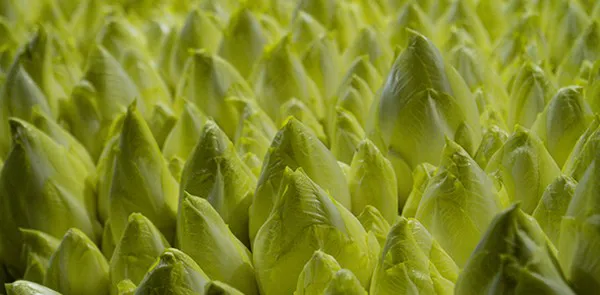In Europe, the farmer protests may have pushed the campaign somewhat into the background, but from February 1st to 7th, Flanders once again celebrated the Week of the Belgian Chicory. That is when this 'Belgian glory' is highlighted, yet it provided much food for thought, says Charles Cattoir of Primalof. "If the pressure on European chicory roots continues like this, we might, in a few years, become too small to remain a retail product," he begins.

This year has, thus far, proven to be quite unique for chicory growers and traders. Excessive rainfall and flooding in Belgium and France led to significant market shortages, resulting in very high prices in December. "Those stayed stable and high after the New Year. Not as high as in late December, but there was still a shortage. Prices briefly dropped but quickly rebounded. It's somewhat contradictory because, on the one hand, the bad weather and harvesting challenges were a nuisance. On the other, these are attractive prices for growers to work with. Prices that are also necessary to be profitable, as all costs skyrocketed in recent years but aren't falling according to general trends."
"Only a few have ample roots in stock this year, and many companies are experiencing shortages, so there will have to be a more mindful approach to stock management. That should normally result in a much-needed higher annual price than in the past two years. However, it remains difficult to predict, as many companies combine chicory and open-field vegetable trading. So, it also depends on when the focus shifts to other products. With the fragmented Belgian landscape, you never know exactly what will happen in advance," says Charles.
Rollercoaster
It is that uncertainty that keeps Charles concerned about European chicory cultivation's future. "In recent years, our sector has been tossed around from one extreme to another. Starting with the 2021 growing year, followed by the bad 2022 buying year. Last year was one of recovery, but conditions in the fields fluctuated from too wet to too dry and back to too wet, resulting in substantial losses ranging from 10% to 30%. We had to decide whether to harvest or not, as many risks were involved. Eventually, we decided against it, as did many others. That means there will be significantly less chicory available in 2024."

"This will, no doubt, cause a rollercoaster in the market, From everything to nothing to everything. It's unpredictable and shows how risky growing roots is and if it's still profitable. Until two years ago, we sourced all our roots externally, but now we manage 65% of our root supply ourselves. Root availability could drop to a minimum in a year like the last."
"Eventually, we'll have to move to a system where buyers pay high prices to cover the risks. That's why it's important to cherish long-term relationships; arable land is becoming increasingly scarce in Belgium. There's sometimes arable land in France intended for export cultivation, but that doesn't seem to be the case this year. There, too, growers are stopping regularly, and the roots are mostly kept within the country," Charles explains.
Regulations
According to him, regulations continue to loom over the sector. "It's also why many growers are taking to the streets, so we can conclude that there's a problem. I think it's great despite the undeniable impact on trade. Everything's growing at present, so we can't just put it on hold, like with, for example, top fruit, but I still welcome it. I hope Europe listens to the growers a bit. Regulations are simply going too far."
"Many pesticides are being phased out, but the products imported from overseas without all those strict rules are fine. Three important phyto-products in chicory farming will disappear after this year. It will become tough if they find no alternative, especially in regions where weeds are a significant problem. Mechanical or sometimes even manual weeding costs plenty of money and labor. Two luxuries that just about no one has," says Cattoir.
"I believe there will be developments regarding pesticides in the coming months. Many people are working tirelessly at solutions, but a niche market like chicory has little priority. Also, once available, the follow-up will impact the current way of working, too. For example, you might have to select varieties per the new agents. So, if some have planted three-quarters of their plot with a certain variety, they may have to toss that away if there are new substances."
"I think we're facing a generally challenging year in 2024, shortages-wise, after which we'll all have to consider new working methods in 2025. The challenges dominate the market and everyone in it. It genuinely concerns me that our chicory will go the same way as open-field chicory. That's declined to the extent that stores only carry it on a small scale and for a short time. If this pressure on hydroponic chicory keeps up, I fear we'll soon become too small to remain a retail product," Charles points out.

Week of the Chicory
Those challenges make it all the more important to focus attention on the craft and the product itself. That is done annually in Flanders with the Week of the Chicory. This year, the farmer protests overshadowed that slightly, but investments have been made in even better visibility. "This year, the various stakeholders decided to focus more on highlighting chicory for a month. Early February was chosen years ago based on sales figures, but in the last three years, those have remained relatively good from January to March. By late March, you usually start approaching the end of the season. The name has remained, but the focus is no longer only on a promotion-filled week."
"That's shifted to good quality rather than flash sales and promos. I think Belgians understand very well that this is the best way to highlight a product. If you can reach consumers and they experience a delicious flavor, you can retain them much better," Charles reckons. "Belgian chicory is the absolute leader in that, and we need to capitalize on that. Then, the larger consumption will follow naturally."
"Perhaps per capita consumption has decreased, but many more people eat chicory now. It's also crucial to win over the younger generation by showing the product's great possibilities. Once you achieve that, you must ensure the sector remains large enough so this Belgian showpiece remains available to everyone. All in all, there are more than enough challenges that we must monitor closely and which undoubtedly require plenty of attention," concludes Charles.
For more information:
Charles Cattoir
Primalof
23 Leeg Bracht
9860, Balegem, Belgium
Te: +32 (0) 483 484 717
charles@primalof.be
www.primalof.be
